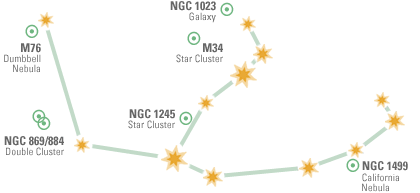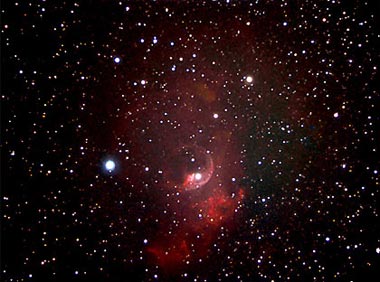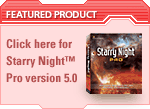 |
||||||||||||||||||||||||||||||||||||||||||||||||||||||||
|
If you have trouble viewing this newsletter, click here.
One of the nicest things about Starry Night is that it can serve as a bridge to people who aren't quite as interested in astronomy as I am. This holiday season I decided that I wanted to show my "normal" friends and family what Starry Night could tell them about Christmas. The Christmas Star, or "Star of Bethlehem", reportedly acted as a beacon for the Three Wise Men to follow from the Middle East to Bethlehem and Jesus' birth. I've heard many explanations over the years: a comet, a supernova, meteors, a supernatural event. Now, I have access to the perfect simulation tool. Here's what I did... From what I could learn, most astronomers and Biblical scholars believe that the appearance of the Star of Bethlehem most likely occurred sometime between the years 7 and 2 BC. Was there anything unusual in the sky that might have caught the attention of the wise men? Just so happened that a very close conjunction of Venus and Jupiter would have been visible in the eastern dawn sky of the Middle East from about 3:45 to 5:20 a.m. on August 12, 3 BC. The two planets came together in the constellation of Leo. To the early Israelites, Leo was a constellation of great astrological significance and considered a sacred part of the sky. The planets came so close together that most people saw it as one object – a very striking sight. With this information, I used Starry Night to go back in time and recreate the August 12, 3 B.C. event. You can do it too...
Two notes...
Finally, for more info on the Star of Bethlehem, check out “Star of Bethlehem: Going back in time to explore its origins” from the fine folks at Space.com. Seth Meyers
Perseus is the mythological hero who saved Andromeda from Cetus, the Sea Monster. Perseus used Medusa's head (lopped off in a previous adventure) to turn Cetus to stone. In December, Perseus is visible in the north-east after dusk. As the night progresses, it rises higher for excellent viewing. There are a number of fabulous sights on show... NGC 869/884, the Double Cluster, is a favorite target and with good reason. Use binoculars to get an overview of this jewel box, then a low magnification in your telescope to bring out the distinctly varied coloration of stars in each cluster. Both clusters are about 7000 light-years away and are part of the Perseus arm, one of the spiral arms of our Milky Way. M76, the Dumbbell Nebula, is another favorite among observers because of its obvious hourglass/dumbbell shape. It's faint but small and so will respond well to magnification. Averted vision will help you see its two distinct lobes and nebulous wisps. NGC 1245, an open cluster, is best viewed with low magnification. Most of the stars are hot blue, but there are some nicely contrasting bright orange stars, cooler and older than their blue house mates. M34, another star cluster, contains about 60 members including several double-stars. The cluster is 1,500 light-years distant and is moving in the same direction through space as the Pleiades. NGC 1023, an very elongated looking galaxy, hangs in space roughly 30 million light-years from the back of your eye. From that distance it's surprisingly bright, especially the middle. Try all magnifications to pick out structure and details. NGC 1499, the California Nebula, is a large emission nebula. Under dark skies, it's bright enough to see with the naked eye. Use low magnification and a nebula filter if you have one. See if you can make out the shape of the state that gives the nebula its name. Sean O'Dwyer
Nature’s Christmas Light Show On December 25th, remember to turn off the lights and check out the natural Christmas decorations above. Good targets to spot include the Pleiades, the Hyades Cluster, the belt of Orion, the W of Cassiopeia and the bright winter stars such as Betelgeuse and Rigel in Orion, Pollux in Gemini, Capella in Auriga and Aldebaran in Taurus. Starry Night will make it easy to find these celestial decorations. Celestial Christmas Tree The Christmas Tree Cluster (NGC 2264) is a large, bright cluster with an associated diffuse nebula. It was discovered by astronomer William Herschel. The cluster is visible to the unaided eye as a fuzzy patch. Binoculars reveal 20 of its brightest members with many fainter ones in the background. This grouping of stars is arranged in a triangular shape reminiscent of a Christmas tree for which this cluster is popularly named. A 6th magnitude star punctuates the top of the 'tree'. NGC 2264 is embedded in nebulosity, which may be detected with a large telescope under dark skies. To the south of the Christmas Tree cluster lies the Cone Nebula, a remarkable object in long exposure photographs but difficult to detect visually. The Cone Nebula and the Christmas Tree Cluster are both part of a larger star-forming region. Modern Day Christmas Star: Venus During the winter holidays, Venus will shine like a modern-day "Christmas star" in the southeast before sunrise. It shines at magnitude –3.9 and is brighter than any other planet or star in the sky.
Photo: Comet c/2004 Q2 was photographed on Sept. 14 by Gianluca Masi and Franco Mallia, as part of an educational project in Italy using the SoTIE telescope in Las Campanas, Chile.
The Bubble Nebula This month's winning photo submission is from Mel Martin. Mel has enjoyed using Starry Night (versions 1 through 5) for many years and takes his celestial photos from Seattle, Washington. The Bubble Nebula’s (NGC 7635) most striking feature is the expanding shell of glowing gas (the bubble) surrounding a hot and massive star.
Photo Notes: NGC 7635-Bubble Nebula, taken August 30, 2004 from Seattle, WA, Mead 10" SCT telescope, Mountain Instruments mount, SBIG ST2000 CCD camera and color filters, with SBIG A0-7.24 minutes each of Red, Blue and Green exposure, and 32 minutes through a hydrogen alpha filter to cut down on the effects of light pollution. Image by Mel Martin. PHOTO OF THE MONTH COMPETITION: We would like to invite all Starry Night users to send their quality astronomy photographs to be considered for use in our monthly newsletter. Featured submissions (best of month) will receive a prize of $25 USD. Please read the following guidelines and see the submission e-mail address below.
|
Dec. 2004
|
|||||||||||||||||||||||||||||||||||||||||||||||||||||||
 |
||||||||||||||||||||||||||||||||||||||||||||||||||||||||
|
|
||||||||||||||||||||||||||||||||||||||||||||||||||||||||

 A comet discovered earlier this year has now moved close enough to be visible to the naked eye under dark skies. Comet Machholz is a holiday season gift for stargazers. It could become as bright as fourth magnitude and hover around at this brightness for about a month beginning right after Christmas. During this interval, the comet will move from southern Taurus on up into the constellation Perseus. Fourth magnitude means that the comet should at be at least dimly visible to the naked eye in dark skies, though better seen in binoculars or telescopes.
A comet discovered earlier this year has now moved close enough to be visible to the naked eye under dark skies. Comet Machholz is a holiday season gift for stargazers. It could become as bright as fourth magnitude and hover around at this brightness for about a month beginning right after Christmas. During this interval, the comet will move from southern Taurus on up into the constellation Perseus. Fourth magnitude means that the comet should at be at least dimly visible to the naked eye in dark skies, though better seen in binoculars or telescopes. 

